Comparative Anatomy- Exam #1
1/105
There's no tags or description
Looks like no tags are added yet.
Name | Mastery | Learn | Test | Matching | Spaced |
|---|
No study sessions yet.
106 Terms
Why study vertebrate anatomy?
morphological adaptations
evolutionary insight
economics
agriculture
medicine
What is the phylum and subphylum of vertebrates?
phylum: chordata
subphylum: vertebrata
What are the current and past characteristics of phylum chordata?
endostyle
update: pharyngeal slits
now an ancestral trait
genes for gill slits much earlier than previously thought
not a chordate feature anymore
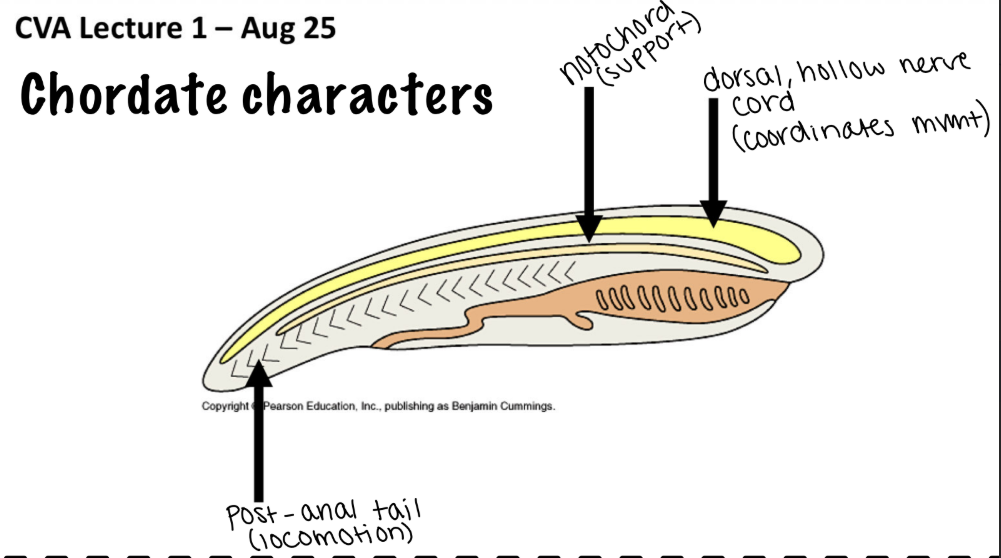
What is the endostyle and the function in chordates?
groove in the pharynx
functions:
secretes mucus for trapping food
becomes thyroid in later vertebrates
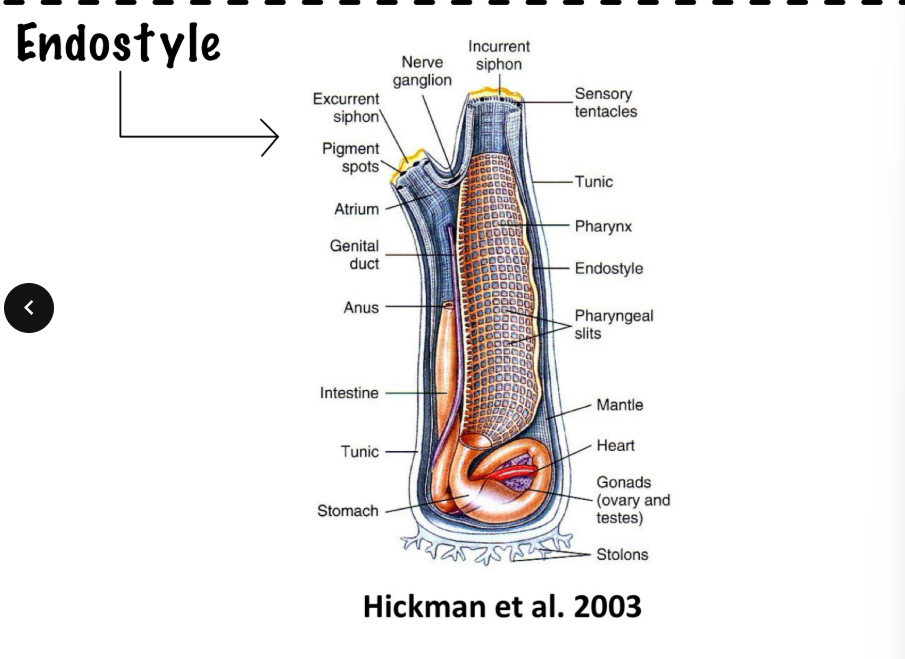
What are the characteristics of the subphylum vertebrata?
vertebrae
cranium
Are hagfish craniates or vertebrates?
they are now considered true vertebrates
What is systematics? What method is used?
study of the evolutionary relationship among organisms
method = cladistics
determines groups of organisms based on evolutionary history regardless of their overall similarity
What is cladistics?
method of systematics
objective: to create monophyletic groups
creates groups based on shared derived characters, not ancestral characters
What is a monophyletic group?
an ancestor and all of its descendants
What is a derived character?
newly evolved from previous state
Where is the outgroup located on an evolutionary tree?
always on the bottom
What is an example of an ancestral trait and an example of a derived trait among frogs, mammals, and fishes?
ancestral: 1 frog, 2 mammals, and 1 fish all have vertebrae
derived: only mammals have hair
Can the absence of a character determine a group?
NO!
Describe cladistic grouping.
no taxonomic groupings
ex: no classes or families
old groups not recognized because of monophyletic groups
What is a paraphyletic group?
group with a common ancestor but some descendants are excluded
Is the bottom or top of an evolutionary tree the oldest?
the base (bottom)
What are sister groups? Give an example.
a group of organisms most closely related to another group
share same branch of tree
ex: hagfish and lamprey
What are the 4 groups that fall under Chordata?
cephalochordata = lancelets
olfactores
urochordata
vertebrata
Describe the general features of cephalochordates.
lancelets
~25 species
marine filter feeders
dioecious
defined by 4 chordate derived characters
general traits:
myomeres
simple brain
caudal fin
cyrtopodocytes
lack gill tissue
Define dioecious.
sexes separate
Define myomeres.
muscle blocks separated by connective tissue
What are cyrtopodocytes? In what group can they be found and where in the body?
found in cephalochordates
excretory cells (remove metabolic waste from blood)
found in pharynx- attached to capillaries
glomerulus: network of capillaries
flushed out with water
transfer wastes to atrium
ventral to dorsal blood flow through pharyngeal bars
blood connect @ sinus venus
sinus = cavity
If cephalochordates lack gill tissue then how do they undergo gas exchange?
diffusion
Describe the circulatory system of cephalochordates.
no heart
ventral aorta and bulbilli do most pumping
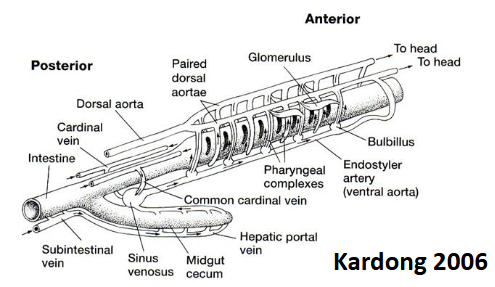
Describe the digestive system of cephalochordates.
food → pharyngeal bars → endostyle → gut
gut: general word for intestine
move digestion in cecum → intracellular and extracellular
water → pharyngeal slits → atrium → atriopore
egestion
What is egestion?
release of undigested food waste
What are the derived characters of the olfactores?
molecular similarities
neural crest cells
originate from developing nerve cord
move to form other structures
Describe the general urochordata.
sea squirts
~3,000 species
marine filter feeders
derived character
tunic: protective covering
What is the tunic of urochordates made of?
cellulose or tunicin
Describe the general traits of tunicate adults.
urochordates
sessile: attached to substrate and immobile
lack some chordate features
monoecious
circulatory system
heart pumps blood in 2 directions
What does monoecious mean?
one individual has both testes and ovaries
Describe tunicate larvae and the importance of the larval stage.
urochordates
free swimming
all chordate features
short lived and then they settle to the substrate and metamorphase into adult
importance of this stage is for dispersal away from sessile parents
Describe the 5 derived characters of subphylum vertebrata.
~70,000 species
derived characters
cranium
vertebrae
3-part brain
better processing and motor control
neurogenic placodes
cell clusters- give rise to sensory organs
muscular pharynx and gut
gill arches support
gill filaments
What is the importance of the muscular gut and pharynx in vertebrata?
muscular pharynx → pump water through pharynx to increase gas exchange efficiency
muscular gut → move food efficiently through different parts of digestive tract
peristalsis: contractions and movement of food
What are the general traits of vertebrata?
duplication of Hox genes
regulate genes that control embryonic development
inner ear- made of semicircular canals
function: balance and equilibrium
Draw the evolutionary tree of phylum Chordata as well as list the derived characters.
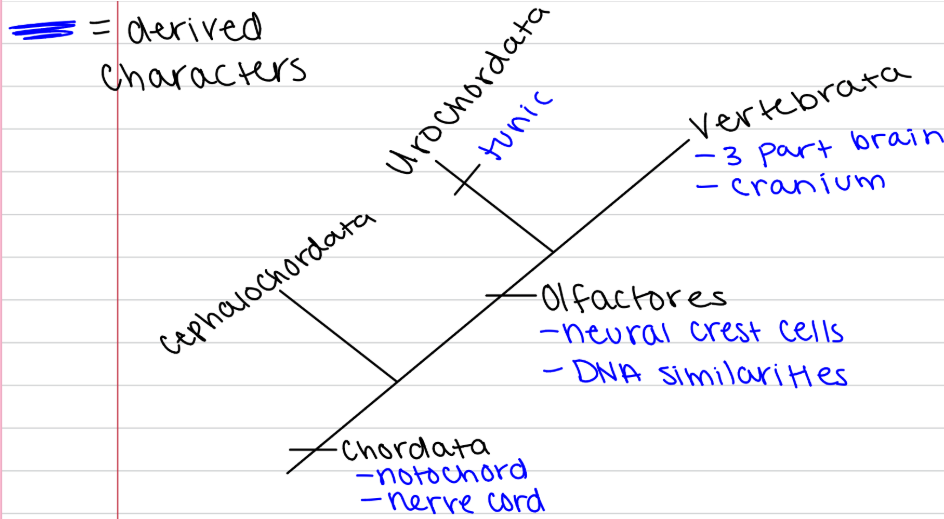
Describe the “Agnathans”
shared ancestral characters
agnatha: without jaws
jawless fishes
ancestral traits:
lack jaws
lack 2 paired fins
gametes released into coelom
What are the groups that fall under “agnathans”
cyclostomes = lampreys and hagfish
myxiniformes = hagfish
petromyzontiformes = lampreys
ostracoderms
extinct
What does the quotations around “agnathans” mean?
not a true monophyletic group
Describe the general traits of cyclostomes and the subgroups.
agnathans
lampreys and hagfish
derived characters:
single nostril and nasal sac
linguinal cartilage supports “tongue”
tongue isn’t homologous to tongue of other vertebrates
velum: pumps water or food into pharynx
includes the groups:
myxiniformes
petromyzontiformes
Describe the myxiniformes (i.e. number of species, location, derived characters, general traits)
agnathans under the cyclostome group
hagfish
~75 species
all marine
benthic, deep water
burrow into sediment
derived character
slime glands
~200 along body
secrete massive amounts of mucus
deters predators
general traits
vertebrae = arcualia
ventral elements
gill pouches- many
1-15 pairs gill openings
most common species only have 1 pair external gill slits
all pouches drain through internal ducts that combine and exit out opening
1 pair semicircular canals
Describe the petromyzontiformes ((i.e. number of species, location, derived characters, general traits, diet and feeding)
agnathans under the cyclostome group
lampreys
~40 species
marine and freshwater
anadromous
larvae are filter feeders
derived characters:
round mouth with buccal funnel
7 pairs of gill pouches
each opens to outside
tidal ventilation: water in and out gill openings
inefficient
use because they are parasites and use buccal funnel to attach to hosts so this lets them feed and respire at the same time.
general traits
vertebrae = arcualia
dorsal elements
well developed eyes
2 dorsal fins
2 pairs semicircular canals
diet and feeding
adults- parasite on fish
buccal funnel and tongue- keratinized teeth
Describe the “ostracoderms”† (i.e. number of species, derived characters, basic traits)
agnathans
extinct (hence the †)
small freshwater and marine fish
derived characters
dermal bones- plates
paired fins
pectoral and dorsal
paired nostrils
Draw the “agnathan” evolutionary tree and include derived characters.
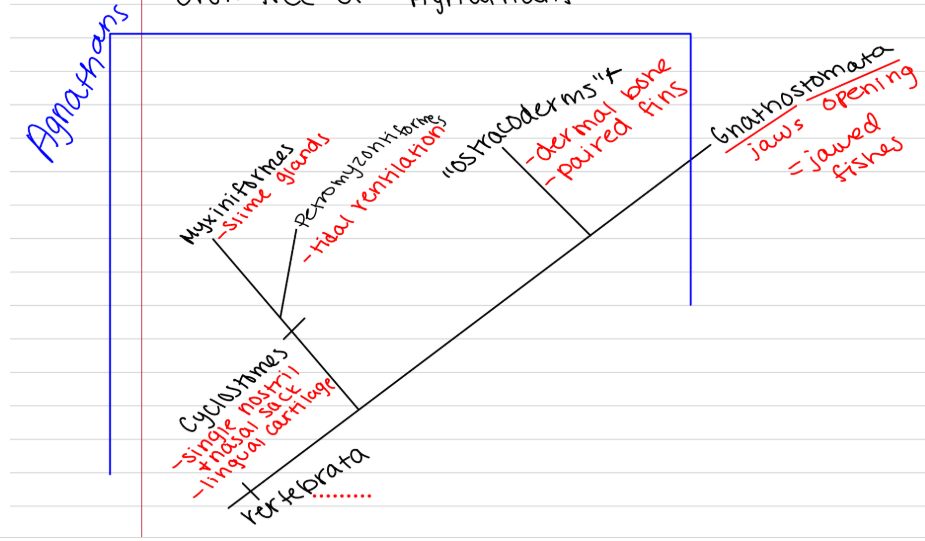
What does Gnathostomata mean?
jaws opening
jawed fishes
What are the subgroups within Gnathostomata?
placoderms (extinct)
Chondrichthyes- cartilaginous fish
Osteichthyes- bony fish
Describe the placoderms.
extinct
members of gnathostomata
jaws
important for:
catching prey
breaking down food and manipulating prey
defense
build nests
paired pelvic fins
3 pairs semicircular canals
What is the difference between ostracoderms and placoderms?
ostracoderms- older, no jaws
placoderms- newer, jaws
Describe the Chondrichthyes (i.e. group they are a part of, general traits, derived characters, subgroups).
part of gnathostomata
cartilaginous fish
derived characters:
scales = placoid
pelvic claspers in males
function: internal fertilization
specialized calcification of cartilage
general traits:
cartilaginous skeleton
mineralization secondarily lost
increased buoyancy
jaws and vertebrae = calcified
series of replacement teeth
tooth only attached in skin so fall out easily
subgroups
holocephali- ratfishes
elasmobranchii- sharks, skates, reys
Describe the holocephali (i.e. number of species, derived traits, part of what groups)
gnathostomata → chondrichthyes → holocephali
ratfishes
~50 marine species
derived traits:
1 pair gill openings
covered by fleshy operculum
palatoquadrate fused to cranium
palatoquadrate = upper jaw
holostylic jaw suspension
Describe the elasmobranchii (i.e. number of species, derived traits, part of what groups, what is special about them)
gnathostomata → chondrichthyes → elasmobranchii
sharks, skates, reys
derived traits:
separate, uncovered gill openings
hyostylic jaw suspension
only anterior palatoquadrate attached to cranium
will allow some upper jaw flexibility
~1250 species
mostly marine
predators- vertebrates and invertebrates
largest filter feeders
Describe the Osteichthyes.
in gnathostomata
bony fish
derived characters:
swim bladder: adjusts buoyancy
dermal rays in fins
subgroups:
actinopterygii: ray-finned fishes
sarcopterygii: lobe-finned fishes
Describe actinopterygii.
Gnathostomata → Osteichthyes → Actinopterygii
>34,000 species
all aquatic niches
derived characters:
multiple radial bones support fin
forebrain develops by folding outward
Describe sarcopterygii.
Gnathostomata → Osteichthyes → Sarcopterygii
~8 species
lobe-finned fishes
mostly freshwater
lungfishes - air breathers
coelocanth- marine
derived characters:
muscular lobes at fin base
single series of bones support fin
Draw the Gnathostomata evolutionary tree and include derived characters.
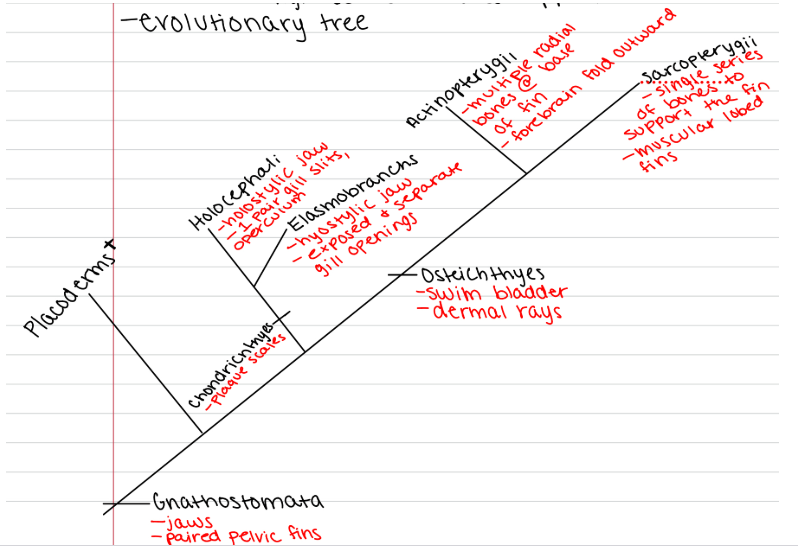
What is the derived character of tetrapoda?
4 limbs with digits
Describe Amphibia.
~8300 species
aquatic or semi-aquatic
respiration and reproduction
need water for reproduction because it prevents the eggs from desiccation
amphibia = double life
have adult and larval stages
groups:
caecilians
salamanders
frogs and toads
derived characters:
pedicellate teeth
2 parts- base and crown
tooth joint
flexible
aids in handling prey
thin skin
mucuous glands
moist skin for respiration
moist because gasses diffuse in/out water into blood
Describe the amniotes.
tetrapoda
derived character: amniotic egg
amniotic systematics- skulls and temporal fenestrae
groups:
synapsida- mammalia
sauropsida- “reptiles” and birds
testudina- turtles
archosauria
crocodilia
aves
Describe the amniotic egg.
= yolk sac + 3 new extraembryonic membranes
yolk sac stores nutrients
amnion and chorion = fluid filled sacs that absorbs shock and prevents desiccation
allantois: stores nitrogenous waste
allantois and chorion will fuse and become highly vascularized (lots of capillaries)
together they function in gas exchange
importance of amniotic egg:
can reproduce on land
embryo can grow larger with better oxygen supply
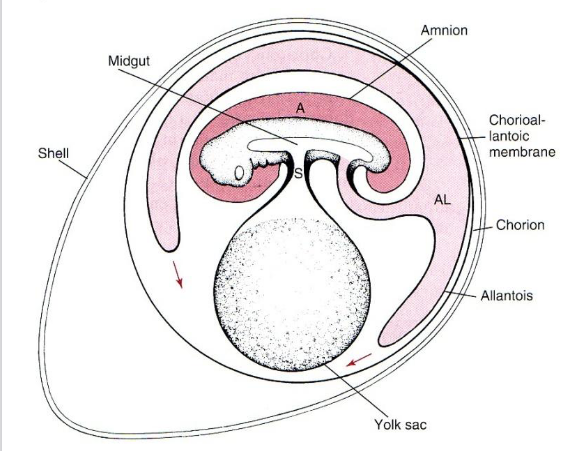
Describe the different skull types in amniotes.
anapsid = no fenestrae
1 fenestra = synapsid
diapsid = 2 fenestrae
function:
increased surface area for jaw muscle attachment and more space for larger jaw muscles
allow different orientation of jaw muscles to improve jaw muscularies

Describe the synapsida.
tetrapoda → amniota → synapsida
mammalia
derived characters:
synapsid skull
hair
mammary glands
~5500 species
new physiology trait: endothermy
endothermy: regulate body temp through production of metabolic heat
Describe sauropsida and the subgroups.
tetrapoda → amniota → sauropsida
“reptiles” and birds
derived traits:
beta keratin in skin
uric acid waste product
diapsida
lizards → birds
diapsid skull (derived)
ophiodiophobia: fear of snakes
lepidosauria
derived characters:
overlapping scales of keratin
transverse cloaca
squamata
derived traits:
hemipenes
paired male copulatory organs
sperm groove
lizards and snakes
~11,000 species
swalloq prey bigger than their mouth
some secondarily lost limbs
Draw the early tetrapoda evolutionary tree and include derived characters.
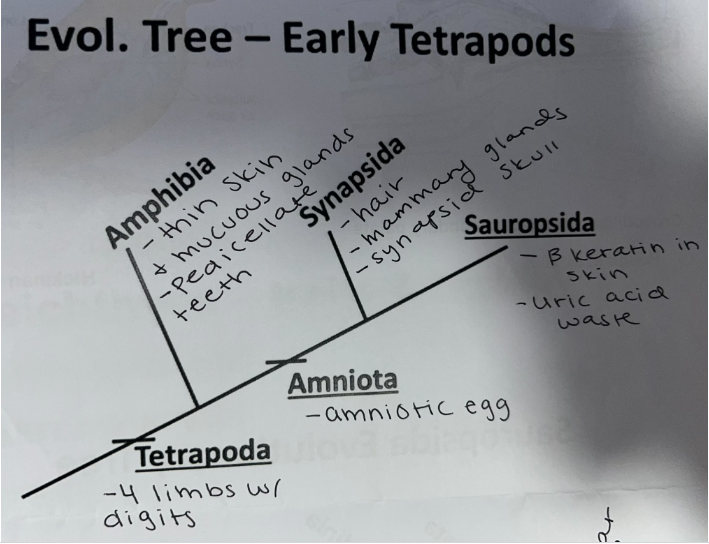
Describe the testudina.
tetrapoda → amniota → testudina
turtles
derived characters:
loss of diapsid skull
anapsid
shell: keratin and bone
~350 species
terrestrial → marine
Describe the archosauria.
tetrapoda → archosauria
derived characters:
antorbital fenestra
triangular shaped orbit
Describe crocodilia.
tratrapoda → crocodilia
24 species
fresh and saltwater
complete secondary palate = derived character
an oval structure separating the oral and nasal cavities
allows them to breathe with food in mouth
often drown their prey
Describe aves.
tetrapoda → aves
birds
~10,000 species
endothermic
derived characters:
feathers
hollow bones
air sacs
What group of tetrapods has the most species?
squamata
Draw the sauropsida evolutionary tree.
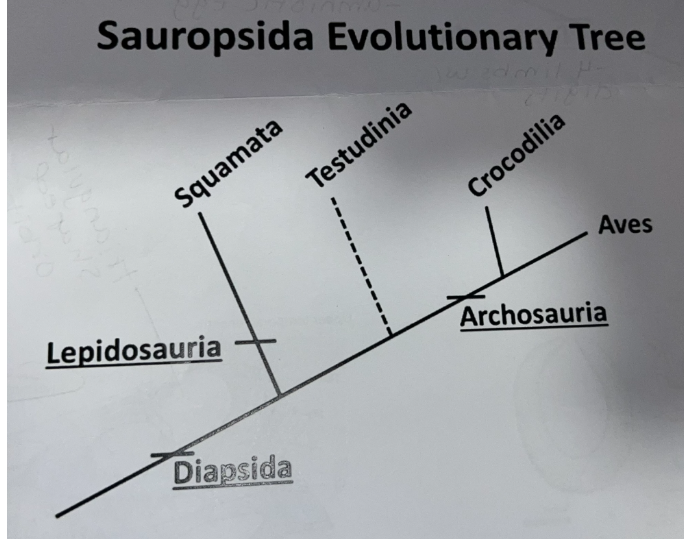
What is integument? Describe the basic structure.
interface
all surfaces, including:
ears
eyes = conjunctiva
conjunctivitis = pink eye
basic structure:
epidermis
multilayered and contains glands
continuous cell division
why? repair damaged cells and replace dead cells
dermis
connective tissue
blood vessels and nerves
makes leather
Describe the non-living coverings of the epidermis.
mucus cuticle
thin coat continually secreted
aquatic species
function:
moisture
anti-bacterial properties
defense
ex: hagfish
stratum corneum
layer of dead cornified cells (infused with keratin and hardens)
why? prevents drying out / desiccation
waterproof
terrestrial vertebrates
Describe epidermis of aquatic vertebrates.
glands
mucus
granular
mucus
chemicals to repel predators
keratin
cyclostomes and tadpoles
cornified spines = “teeth”
keratin “beaks”
Describe tetrapod glands.
mucus gland is absent from most (except amphibia)
amphibia has granular glands
secrete toxins
pheromones: chemicals that affect the behavior and physiology of other animals (ex: courtship and mating)
bright colors that advertise an animal’s toxicity or distastefulness = aposematism
Describe avian glands.
uropygial gland
secretes oil for feather conditioning
prominent in waterfowl
for waterproofing mostly
Describe mammalian glands.
sebaceous
opens into hair follicle
produces sebum
oily conditioner
ceruminous
produce cerumen (ear wax)
outer ear canal
works with hairs in ear canal to capture insects and debris from getting to ear drum
sudoriferous (“sweat glands”)
watery secretion
function: thermoregulation via evaporative cooling
distribution varies among mammals
scent
sebaceous and sudoriferous
pheromones
ex: cats rubbing on you
defense chemicals
ex: skunks
castoreum: beaver anal sac oil used for rasberry flavoring
mammary
compound alveolar
# related to # offspring
produce milk that is high in lipids
Describe tetrapod epidermal scales and how they works specifically in squamates, turtles, birds, and mammals.
stratum corneum derivative
thickening of s. corneum
function: protection against wear
squamates
overlapping with joints
2 layers of s. corneum
turtles
scutes
non-overlapping
either shed or continually grow
shell
dorsal side = carapace
ventral side = plastron
birds
localized in most
mostly on feet
mammals = rare
armadillos
beavers (tails)
most heavily scaled mammal: pangolin
Describe claws, nails, and hooves.
s. corneum derivatives
'claws- first in amniotes
shed and replace in some groups
nails and hooves- continuously grow and wear down
mammals with hooves = ungulate
Describe feathers.
s. corneum derivative
structure
basic contour feather
calamus = “quill”
rachi = shaft
vane: flat surface composed of barbs
plumulaceous barbs: loose and not connected
pennaceous barbs: tightly connected into a vane
feather types:
contour feather
A. Body- streamlined shape
B. Flight- stiff, flat surface for lift and thrust
bristle- tactile receptor
filoplume- air receptor
down- insulation
no central shaft
semiplumes- insulation, streamlining, mate attraction
pterylae: feather tracts
bare spots between feather tracts = apteria
Describe hair.
s. corneum derivative
pelage: dense covering of hair
guard hair: protection and create color patterns
underhair: tightly packed for insulation
arrector pili: smooth muscles attached to hair follicles
adjust hair position
increase ability to trap hair
cause goosebumps in humans
What are the differences between horns and antlers?
horns
ex: bison
made of keratin (derived from epidermal)
antlers
ex: moose
made of dermal bone (from dermis)
What are the different horn types?
bovine
sheath of keratin covering dermal bone
hollow
never shed
pronghorn
branched and sheath sheds
hair
mass of keratin fibers
sits on nasal bone
never shed
Describe antlers.
epidermis
from dermal bone’
grow underneath “velvet” integument
velvet is from epidermis and dermis
shed and replace annually
Describe ossicones.
epidermis
giraffes have these
bony core develops separate from skull
dermal bone core
covered with skin
never shed
function
competition?
thermoregulation?
can’t know for sure
Describe the dermis.
chromatophores: pigment cells
aposematism
matrix of collagen fibers
thick
support and protection
mineral deposition
assist in bone production
Describe the dermis of “ostracoderms” and placoderms
plates made of dermal bone
primitive dermal bone
thick and has 4 layers
composed of:
compact bone
spongy bone
dentin
enamel
denticle: projection of dentin and enamel
Describe the types of scales present in the Chondrichthyes.
placoid scales
bony plate and spine
spine = denticle
give rise to teeth in gnathostomes
cosmoid and ganoid scales
both made of spongy (vascular) and compact (lamellar) bone
coismoid
cosmine (type of dentin) layer under enamel
extinct sarcopterygii
ganoid
lacks dentin
different enamel - ganoin
primitive actinopterygii
ex: Gar
elasmois
thin layers of compact bone
very flexible
cycloid
smooth all around
ctenoid
comb-like border
sarcopterygii and actinopterygii
Describe the dermal bone of tetrapods (osteoderms, turtle, birds, and mammals).
compact bone
osteoderms: small bony scales
within dermis- not visible
ex: caecilians
amphibs
crocodiles
turtle shell
dermal plates under scutes
fused and immobile
fused to ribs and vertebrae
lacking in few
ex: leatherback, some freshwater turtles
birds- mostly absent
mammals- rare
dermal armor in armadillos
osteoderms in skin
What is the skeleton composed of?
mineralized tissue
cartilage and bone
bundles of collagen fibers
tendons: attaches muscle to bone
ligaments: attaches bone to bone
ex: ACL (anterior cruciate ligament)
What are the two categories of bone?
membrane
endochondral
Describe membrane bone.
forms from membranous sheets of mesenchyme
mesenchyme: undifferentiated tissue
= dermal bone when made in dermis
Describe endochondral bone.
produced only with cartilage precursor
also called replacement bone
growth- ex. long bones
3 growth areas
middle of shaft (short lived)
epiphyseal plates = 1 at each end
cartilaginous
process
cartilage produced then ossifies
bone growth continuous throughout life (=indeterminate)
birds and mammals- plates ossify at maturity (= determinate)
What 3 parts make up the axial skeleton?
vertebral column
ribs and sterna
skull
Describe the general properties of vertebrae
composed of:
centrum
neural arch
apophyses= processes
hem arch- tail (fishes)
contains caudal artery and vein
other apophyses
chevron bone in amniotes
caudal vertebrae
homologous to hemal arch
zygapophyses
articulating facets
limit dorsoventral flexion
when processes are reduced = increased flexibility
Describe the “agnathan” vertebral column.
hagfishes and lampreys
simple rudimentary vertebrae = arculia
Describe the jawed fish vertebral column.
little specialization
2 types of vertebrae:
dorsals = trunk
caudals = tail
design allows lateral flexibility only (swim side to side)
Describe the elasmobranch vertebral column (what is present, what kind of centra, arches)
notochord present
amphicelous centra = concave at ends
limited flexibility
bone never forms
arches
paired cartilaginous plates
dorsal plates = neural arch
ventral plates = hemal arch
elastic ligament
connects neural arches
limits dorsoventral movement
present in all jawed fish
What are the two types of vertebrae present in jawed fishes?
dorsal and caudal
Describe the actinopterygii vertebral column.
ossified
amphicelous centra
supraneural bones
may fuse to vertebrae
support dorsal fin muscle
Describe the tetrapod vertebrae- centra
amphicelous
some amphibs and squamates
concave at ends
opisthocelous
concave at posterior
salamanders
improved flexibility
procelous
concave at anterior
frogs/toads and most sauropsids
increased flexibility
acelous
not concave
w/ intervertebral disks in between
mammals
helps to distribute weight evenly
heterocoelous
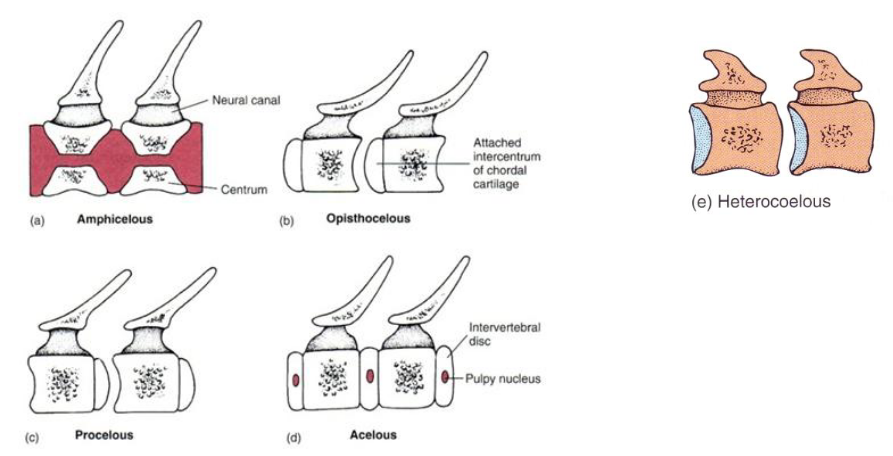
Describe the regionalization of the tetrapod vertebral column.
new challenges on land:
support large body mass without dense water
increased flexibility for locomotion
other trends:
ribs on thoracic vertebrae only
sacral vertebrae support pelvic girdle and hindlimbs
exceptions:
snakes and caecilians
most vertebrae have ribs
little specialization
snakes have the most vertebrae of all vertebrates
function in snakes:
increased flexibility
increased ribs support trunk (axial) muscles